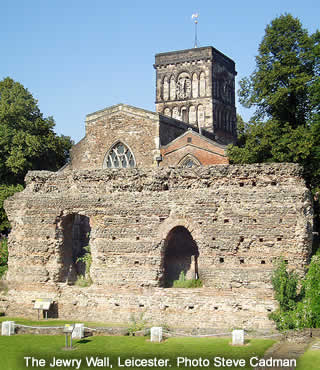Leicester |
|
 |
|||
Britain > East Midlands > Leicester |
||||
In architecture, amenities and population, few other cities are as diverse |
||||
|
||||
You wouldn't guess it but, with over 2000 years of history, Leicester is one of the oldest cities in the UK. It didn't have a name until the Romans arrived; they christened it "Ratae Corieltauvorum". This title has since been abandoned in favour of something pronounceable, but there are other reminders of the Ancient Roman presence. |
||||
The biggest is the Jewry Wall, a 8-metre section of masonry that's taller than most Roman ruins in the country. Once, it overlooked the public baths; nowadays it stares at two of Leicester's newer structures. One, St. Nicholas' Church, is "merely" 1100 years old, although the building has benefited from more recent renovations. It's nevertheless the oldest place of worship in the city. The other is the Jewry Wall Museum, established in honour of the ruins. It celebrates local architecture, and Roman crafts like painting and mosaic. |
||||
As well as remembering its past, Leicester keeps one eye firmly on the future. Another city museum documents the achievements humanity made two thousand years after the Roman invasion - when we left this planet altogether. The National Space Centre is the largest exhibition of its type in Britain. The six galleries share the secrets of the cosmos, and test whether you'd make the grade as an astronaut. At the planetarium, visitors are chucked into that great black nothingness - or at least, a detailed projection of it. |
||||
It's a long journey from Roman bath houses to space exploration. Elsewhere in Leicester, you can see how society moved from one milestone to the other. At Abbey Park, for example, you can see the ruins of a 12th century abbey, and a 17th century stately home. Incidentally, there's also a formal garden, a boating lake and a miniature railway. They're not of the same age, but that doesn't mean they aren't lovely places to spend an afternoon. |
||||
The variation in architecture is matched by Leicester's diverse population. A third of the city is from Asia, making this an appropriate home for places like the Guru Nanak Sikh Museum, and the Hindu Jain Centre. They aim to educate people in the origins and beliefs of faiths they might not be completely familiar with. |
||||
No part of the city is as strongly affected by the Asian population as Belgrave Road, where the clothes and food shops make an assault on the senses. October is the best time to visit, as the annual Diwali festival uses fireworks and dancing to turn the place into an explosion of colour. It's reportedly the biggest Diwali celebration outside of India itself. Naturally, if you start getting peckish there's no end of restaurants to choose from. The oldest, the Taj Mahal, has been open for over four decades. |
||||
A more familiar shopping experience can be had in the city centre - "familiar" in this case meaning incredibly slick and modern. There's the Highcross Centre, for example, a relatively new construction of glass walls and bright lights. The independent shops around St Martins Square offer a low-key alternative to the glitz and glamour. |
||||
Leicester's arts scene is similarly eclectic. The Caribbean Carnival is the biggest outside London, and the Short Film Festival is constantly expanding. The Comedy Festival outdoes anything that even the capital has to offer. The city's cultural HQ is Curve, a state-of-the art theatre and concert hall. Phoenix Square is just as contemporary. It focuses on film and digital media, with an unpredictable line-up of cinema, performance and community events. |
||||
|
Pocket Britain is optimised for use on a smartphone or tablet with internet access. All content is subject to copyright. All reasonable methods have been used to ensure information supplied is accurate at the time of publication. However, it is advisable to check information before relying on it. Privacy Policy |